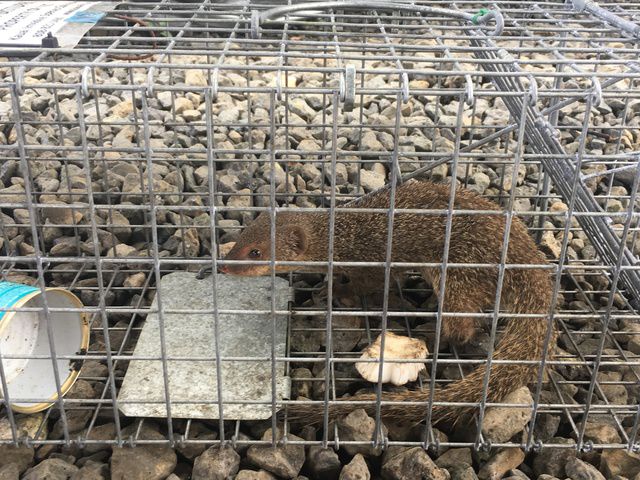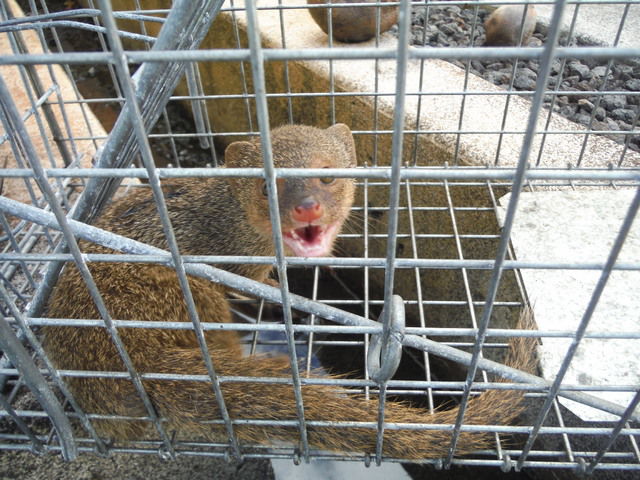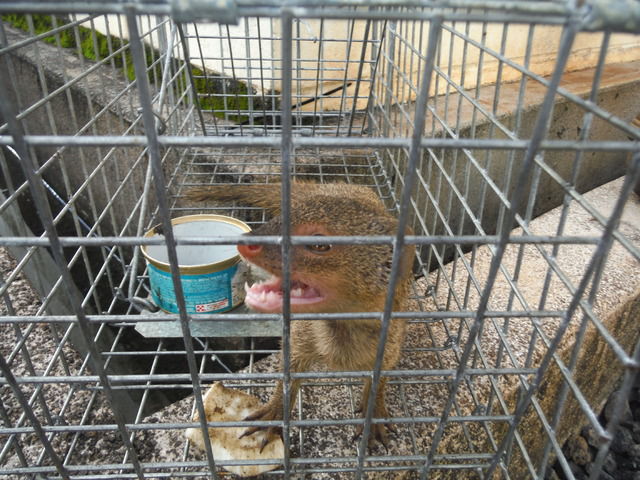LIHUE — The first live mongoose in four years was captured on Kauai Tuesday morning when the unwelcome stowaway was seen in a bread shipment from Oahu at the Lihue Airport. After it was spotted, the juvenile mongoose slipped into
LIHUE — The first live mongoose in four years was captured on Kauai Tuesday morning when the unwelcome stowaway was seen in a bread shipment from Oahu at the Lihue Airport.
After it was spotted, the juvenile mongoose slipped into the neighboring Hawaiian Airlines cargo area. Aloha Air Cargo and Hawaiian Air cargo employees reported the mongoose to the state Department of Agriculture around 5:45 a.m.
“It is unlikely this captured mongoose is from a breeding Kauai population in view of the fact that it was witnessed exiting a recent cargo shipment,” Raymond Kahauneale, Kauai Invasive Species Committee operation supervisor, said in a statement sent to TGI.
KISC and HDOA field teams responded to the mongoose report and set a trap line around the cargo facilities. At 8:15 a.m., the mongoose was captured and “humanely euthanized by KISC,” according to HDOA.
The entire event took place in the span of a little more than three hours. Rachel Smith of KISC said the quick response was one of the reasons the capture was successful.
“As a small staffed non-profit, KISC relies heavily on the Kauai community to help be our ‘eyes and ears’ and report our target species,” Smith said. “We couldn’t do what we do without public support. Collaboration between agencies and community members is key in dealing with imminent invasive species threats.”
Tiffani Keanini, KISC program coordinator, agreed. “The collaborated effort of HDOA, KISC and the Kauai community made this a successful rapid response,” she said.
The last time mongoose were spotted on the island was in 2012 in the Young Brothers port in Nawiliwili Harbor and the Kauai Marriott, according to HDOA.
Mongoose threaten the endangered bird populations in Hawaii. The islands of Kauai and Lanai are the last of the archipelago without known mongoose breeding populations. They transfer between islands in cargo or shipments coming in by plane or boat, according to KISC.
“Preventing mongoose from becoming established will help to protect the limited number of endemic seabird, waterbird and forest bird populations, some of which are only found on Kauai,” Kahauneale said.
In order to protect the species on Kauai and all of the islands, the state is currently working on a Hawaii Interagency Biosecurity Plan, the draft of which is open for public comment until Oct. 21.
It is a collaboration of several state, county, local and federal entities and will address gaps in the state’s biosecurity by creating policies to prevent invasive species from making their way to Hawaii, creating policies that support inspecting incoming items for pest entry, and creating policies that support detecting and responding to new invasive species, as well as controlling established populations.
In total, the plan has 150 actions that would enhance the biosecurity system, according to DLNR, with 10 key areas highlighted. They include E-manifest and intelligence gathering, renewed focus on human health, enhanced control of established pests and minimized inter-island spread.
“Proper biosecurity regulations can stop the introduction and spread of invasive plants, insects, animals and pathogens,” Kahauneale said.
Ports on Kauai and throughout the islands will continue to be monitored by HODA and the U.S. Department of Agriculture.
A copy of the draft biosecurity plan is available at http://hdoa.hawaii.gov/blog/main/biosecurityplan/.
To submit comments on the plan, email Joy DeBruyn at H.T. Harvey & Associates at: jdebruyn@harveyecology.com.
Mongoose sightings can be reported to HDOA at 643-PEST or KISC at 821-1490.




